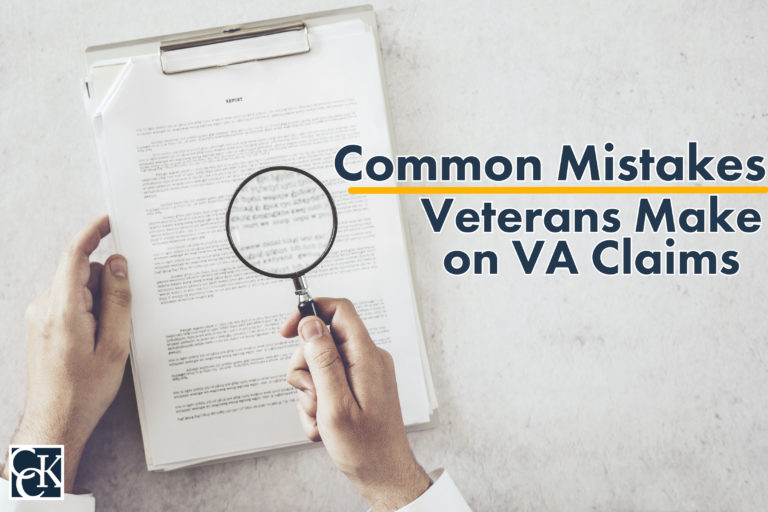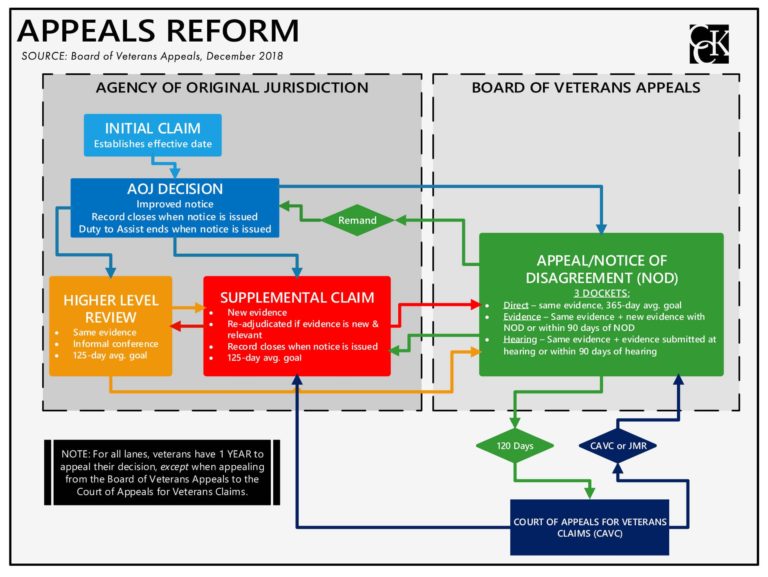Common Mistakes Veterans Make When Filing for VA Benefits

CCK Law: Our Vital Role in Veterans Law
When it comes to filing for VA disability benefits and compensation, the process can be complex, frustrating, and full of confusing steps. This unfortunately leads many veterans to make common mistakes that end up harming or delaying their disability claims.
If you are a veteran filing for disability with the Department of Veterans Affairs (VA), then you should be aware of the pitfalls that often affect your fellow servicemembers. This article will guide you through the most common mistakes veterans make during the claims process, as well as solutions that can help you build a stronger case.
Key points of this article include:
- Not all evidence is needed at the time a veteran first files their VA disability claim. In fact, the longer a veteran puts off filing to gather more evidence, the later their effective date will be, which means they may earn substantially less retroactive pay.
- Establishing service connection is key to a successful VA claim. Service connection is when a veteran can prove that their disability is related to their military service. There are multiple types of service connection, each with their own important components.
- When it comes to disability claims, some evidence is more valuable than others. Veterans should know the proper kinds of evidence to submit to make their claims as strong as possible.
Mistake #1: Waiting to File Your VA Disability Claim
On many occasions, veterans will wait to file their VA disability claims until they have obtained all the evidence they want to submit or until their condition has reached a certain level of severity. While these factors are important, it is also important to recognize that waiting to file can delay your effective date.
An effective date is the date that a benefit became effective and it used by VA as a start date for the payment of disability benefits for a claim. Importantly, the effective date of a claim determines the amount of retroactive benefits a veteran will receive. Generally speaking, the earlier the effective date, the more back pay a veteran will receive.
VA allows veterans to file a claim and then supplement that claim later on with additional evidence. Veterans may also submit legal arguments after the claim has been filed. Therefore, filing a claim as early as possible will result in an earlier effective date than if the veteran waits until they have collected all the evidence they wish to submit.
Even if VA initially denies your claim, your effective date will be preserved as long as you appeal in a timely fashion. If the veteran was granted service connection but was unable to submit the evidence necessary to demonstrate the need for a higher rating, the effective date will be preserved as the date the claim was originally filed and then the veteran can submit the additional evidence as part of an appeal to obtain an increased rating. Therefore, waiting to file a claim for VA benefits can potentially cause you to miss out on more compensation.

Waiting to File and VA’s Duty to Assist
Additionally, filing a claim can sometimes trigger VA’s “duty to assist.” Duty to assist essentially means that VA has a duty to go out and obtain evidence on the veteran’s behalf. Examples of such evidence might be medical records or service records.
This means there is very little benefit in waiting to file a claim in order to obtain evidence, and doing so may end up simply being detrimental to a veteran’s case in some instances, as it can cost them an earlier effective date. Since retroactive benefits are awarded based on a veteran’s effective date, it is important to have as early an effective date as possible, as this will result in more compensation.
Mistake #2: Filling Out Forms Incorrectly
In order to receive disability benefits, veterans must first file a claim with the Department of Veterans Affairs. VA allows veterans to file initial claims for disability benefits in a number of ways, including:
- Online, using VA.gov;
- By completing VA Form 21-526EZ: Application for Disability Compensation and Related Compensation Benefits and mailing it to the Evidence Intake Center or sending it by fax;
- With a legal representative, such as a Veterans Service Organization (VSO) or accredited attorney or agent; or
- At a VA Regional Office with help of an employee.
Regardless of how veterans choose to file their VA disability claim, it is important that they do so correctly. If not, their claim may be denied or the process may be delayed. Additionally, if VA does not accept a form because it was not filled out correctly, or because it was the wrong form, the veteran could be at risk of losing their effective date, and, in turn, their retroactive benefits.
In cases like this, VA may contact the veteran for clarification regarding a form or ask the veteran to fill out a new form. If this happens, it is important to fill out the new form or reply to VA as soon as possible, because there is often a deadline. Not meeting the deadline in time could put the veteran’s claim or appeal in jeopardy.
What Are the Most Important VA Forms?
Some of the most important forms veterans should rememeber include the following:
- VA Form 21-526EZ is the formal application veterans must fill out in order to earn disability compensation. This form is comprised of eleven sections in total, several of which are very important for veterans to complete in full. The sections address several categories, including information regarding the veteran, the veteran’s service, and the veteran’s condition(s).
- VA Form 21-8940 is a form veterans submit in order to gain increased compensation on the grounds of unemployability. This form is essential for veterans looking to apply for TDIU.
- AMA Forms including (1) VA Form 20-0995, Veteran’s Supplemental Claim Application; (2) VA Form 20-0996, Application for Higher-Level Review; and (3) VA Form 10182, Notice of Disagreement. These forms were introduced by VA under the Appeals Modernization Act. Each form corresponds to a review option, or lane, within the AMA appeals system.
Mistake #3: Not Filing for Secondary Conditions
A secondary service-connected disability is a disability that resulted from a condition that is already service connected. There are several ways that a primary disability can cause a secondary disability: for instance, some diseases lead to other health complications that could become serious enough to be considered a secondary disability.
Common examples of secondary service-connected conditions include:
- Radiculopathy secondary to back disabilities
- Peripheral neuropathy due to diabetes mellitus
- Depression due to orthopedic conditions
- Hypertension secondary to PTSD
- Erectile dysfunction secondary to prostate cancer
Tips for Filing for Secondary Conditions
It is important for veterans to file for secondary conditions at the same time that they file for primary conditions for several reasons:
- First, it is likely that the evidence in support of the primary condition will also pertain to the secondary conditions. This allows VA to clearly see that the two conditions are related to one another and should therefore be granted benefits together.
- Second, the effective date for the secondary service-connected conditions may match that of the already service-connected condition, again resulting in a larger retroactive award.
Detailing all the veteran’s secondary conditions, or residuals of their primary condition, can also be vital in receiving benefits for secondary conditions later. If a veteran does not outline their secondary conditions, VA may only grant service connection for the primary condition and overlook the evidence linking the secondary conditions to the primary condition because they were not detailed, or not detailed thoroughly, in the original claim.
Explaining to VA, clearly, what conditions were caused by an already service-connected condition, or a primary condition that the veteran is seeking service connection for, can help outline the veteran’s eligibility for secondary service connection disability benefits.

Mistake #4: Failing to Obtain a Medical Opinion
VA will often deny veterans’ claims based on a lack of medical evidence linking their conditions to their time in service. As such, a medical opinion from an expert or a nexus letter from a private healthcare provider can make a big difference. A nexus letter is a document prepared for a veteran by a medical professional that explicitly connects an in-service event to the current condition for which a veteran is seeking service-connected compensation.
Veterans often make the mistake of relying on Compensation & Pension (C&P) examinations alone for their claims, which may not adequately represent the true nature or extent of their disabilities. Expert opinions and nexus letters may be helpful in this case, as they can provide a clearer picture of the veteran’s symptoms or even counter the VA examiner’s findings. The veteran’s physician, or a medical provider, can provide a nexus letter. Alternatively, accredited representatives, or attorneys, may also be able to obtain an expert medical opinion to serve as the nexus letter.
Typically, a strong nexus letter should:
- Be written by a licensed professional in the appropriate medical or clinical field;
- Be based on the veteran’s service medical and personnel records;
- Be based on the veteran’s medical history before, and following, service;
- Address whether it is “at least as likely as not” that the veteran’s disability was incurred in or caused by service; and
- Provide supporting rationale for the conclusion, or in other words, the medical professional “shows their work” by elaborating on how they reached their determination
Veterans may also fill out, or have their treating physician fill out, a Disability Benefits Questionnaire (DBQ). These are forms created for the veterans’ use in the evaluation process for VA disability benefits. The forms allow the veteran, or their healthcare provider, to answer questions about aspects of their disability, including symptoms, severity, possible cause, and relation to other disabilities.
Mistake #5: Submitting Evidence That is Not Relevant to the Claimed Condition
When filing for VA benefits, veterans may be tempted to send all their service and medical records to VA. In doing so, veterans might send too much paperwork, making it difficult for VA to locate the pertinent evidence that is most relevant to the claimed condition.
In submitting records to VA, the veteran should be certain that the records are pertinent to the conditions for which they are seeking service connection. Submitting extraneous medical information regarding non-service-connected claims could weaken the veteran’s case or prolong a decision from VA.
In other words, while it is important to include evidence with VA disability claims, veterans must ensure the evidence is necessary to get benefits. Otherwise, it will likely cause undue delays and VA rating authorities might overlook what is actually important.

Mistake #6: Not Understanding How VA Grants Disability Benefits
Many veterans are unaware of how the VA disability claims process actually works. While it does involve filling out forms and waiting for benefits, it can be much more complicated than that.
Establishing Service Connection
VA only awards disability compensation when a veteran can prove their disability is somehow a result of their military service. This is called establishing service connection, and there are three primary components:
- (1) the veteran must have a current, diagnosed condition;
- (2) the veteran must have experienced an in-service event, injury, or illness; and
- (3) the veteran must have a medical nexus linking their current, diagnosed condition to the in-service event.
Generally, if a veteran can provide these three key pieces of evidence in regard to a compensable disability, VA will likely grant their claim and accompanying benefits. If they are missing any of the three, however, there is an increased chance their claim will be denied.
For example:
Say a veteran’s service records show repeated head injuries or head injury residuals. While this is excellent evidence of an in-service event, unless the veteran can also provide a current diagnosis that they experience head injury residuals, the veteran will not receive disability benefits. Additionally, the veteran would need a nexus letter linking those head injury residuals to the repeated head injuries that occurred during service.
Overall, while a veteran’s suffering may be clear to them or their family, they still must establish their condition as service-connected to VA in order to receive compensation. Establishing the three elements of service connection is necessary for VA to recognize that the condition was caused or exacerbated by service.
Increased Rating Claims

For increased rating claims, veterans should make sure that they understand how their disability is rated under diagnostic codes. This is because, in order to earn an increased VA rating, the veteran will have to indicate that their disability meets the criteria outlined for the increased rating.
For example:
- Say a veteran is currently service-connected at the 30 percent level for migraine headaches. The 30 percent rating indicates that VA acknowledges the veteran’s headaches are typically “prostrating” and “occur on average of once a month” over the course of several months.
- Eventually, the veteran decides to seek out an increased rating, believing their headaches should actually be rated at the 50 percent level.
- In order to be awarded this increased rating, the veteran will have to demonstrate to VA that their headaches meet the criteria for a 50 percent rating. The crtieria for such headaches consist of “very frequent completely prostrating and prolonged attacks productive of severe economic inadaptability.”
- If the veteran does not meet these criteria, or cannot demonstrate meeting these criteria, VA will not award the increased rating of 50 percent.
In other words, demonstrating entitlement to an increased rating requires meeting the next level contained in the diagnostic criteria.
Mistake #7: Not Continuing to Appeal After Receiving a Denial from VA
After receiving a denial from VA, many veterans may feel as though there is nothing left to do. Veterans may feel exhausted from the VA claims and appeals process and want to give up on their claim. However, if the veteran does not appeal the denial, they could lose their effective date, and essentially any retroactive benefits from that date if they are able to secure a positive decision in the future.
Veterans have the right to appeal unfavorable decisions from VA. In other words, if you receive either a denial or a disability rating that is lower than you deserve, you can disagree with VA’s decision and continue to seek service connection or an increased rating.
Veterans are highly encouraged to appeal unfavorable decisions in a timely manner in order to preserve their effective dates. Once again, effective dates are important as they correspond to the amount of retroactive benefits you will receive.
Under the AMA appeals system, veterans can chose from three different review options, or lanes, when filing an appeal:
- (1) the higher-level review lane;
- (2) the supplemental claim lane; or
- (3) the Notice of Disagreement lane (i.e., appeal to the Board of Veterans’ Appeals).
Continuing to pursue a claim through the appeals process allows a veteran to preserve their effective date, and could entitle them to a larger sum of retroactive compensation down the road. Often, pursuing a claim can lead to securing other VA benefits as well, such as health care or education benefits.

Why Should Veterans Not Give Up When Their Claim is Denied?
“Abandoning” a claim, or not appealing it within VA’s timeframes, can have consequences. If the veteran decides later to file for that condition again, their original effective date will no longer be preserved, meaning the date that they refile for the condition will be the new effective date.
The retroactive benefits that could have been awarded if the first claim had not been abandoned will be lost, and benefits will only be awarded from the time the claim was filed the second time. In some cases, the veteran may be able to secure an earlier effective date, however the best way to keep the original effective date would be to keep the claim up to date by filing an appeal within the allotted time after a denial (i.e., generally one year).
While the VA claims and appeals process can be lengthy and sometimes discouraging, it is important to keep up with one’s claim and file any appeals in order to receive the full benefits to which you are entitled.
Mistake #8: Not Seeking Representation to Assist with the Claims Process
The VA disability claims process can be very complex as the regulations are constantly changing and the procedures are continuously evolving. For instance, in recent years, VA underwent a complete overhaul of its appeals process, transitioning from the Legacy appeals system to the Appeals Modernization system.
As this shift brought many changes to how veterans file claims and appeals, it may be useful to have a knowledgeable representative helping you navigate the updated processes. Representatives can help gather evidence to support your case and ensure that your claims and appeals are filed correctly and in a timely manner, adhering to all deadlines. If this sounds like support you need, consider reaching out to CCK Law for a free evaluation of your claim.
Was Your VA Disability Claim Denied?
The experienced attorneys and advocates have spent decades successfully representing veterans before the Department of Veterans Affairs and the Court of Appeals for Veterans Claims. If your VA claim has been denied, our office may be able to help.
Call CCK Law today at (800)-544-9144 or contact us online for a free case evaluation.
About the Author
Share this Post

